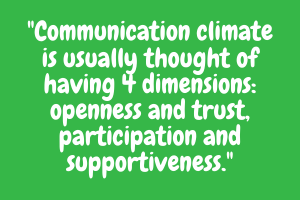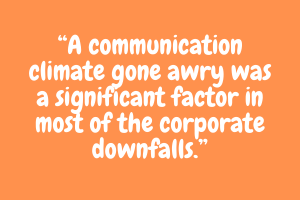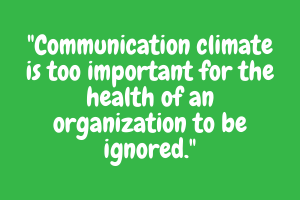.png?width=1280&height=748&name=b071_1%20(2).png)
As internal communicators, we tend to spend most of our time creating messages and seeking to deliver them through an effective array of online and offline channels. This alone is more than enough to consume all of our energy. So, why waste time on something that cannot be easily fixed and is not even necessarily our responsibility?
Communication climate, a metaphor for the quality of the relationships within an organization, is one of the key drivers of effective employee communication. In spite of a growing body of scientific research that underscores the vital role of communication climate, the topic seems to remain conspicuously absent in the average internal communication strategy.
Is the communication climate the elephant in the room?
What is communication climate?
Communication climate, a specific aspect of organizational climate, is usually thought of as having four dimensions: openness and trust, participation and supportiveness.

Openness and trust refer to the degree in which employees perceive the organization's communication practices as open and trustworthy. These two dimensions
Participation refers to the extent in which employees experience having a voice in the organization.correlate strongly and encompass all aspects of communication: downward, upward and lateral, including leadership and line communication and the interactions within and between teams.
Supportiveness refers to the experience of feeling taken seriously by supervisors and colleagues.
An organization's communication climate can be thought of as the sum of many different micro-climates on the level of individual teams.
Why should internal communicators care about communication climate?
The key thing to remember about communication climate is this: it is the single most important influencer of organizational identification, which in turn is the most important influencer of strategically aligned behavior. In other words: the how of internal communication is more important than the what. In even simpler terms, climate beats content.

The quality of an organization's communication climate has real-world consequences, both positive and negative.
Southwest Airlines, for example, has anchored numerous communication climate principles in its vision, strategy and management and communication practices. This approach has helped Southwest to maintain a top position in its industry for decades, as well as benefit from a highly engaged and loyal workforce.
Unfortunately, 'climate exemplars' such as Southwest are dramatically outnumbered by lesser gods, among which Boeing is only the latest to dominate the headlines.
It is not far-fetched to allege that a communication climate gone awry was a significant factor in most of the corporate downfalls and disasters the world has seen in the last decades. Think of NASA, Enron, BP, Nokia, Wells Fargo, the list is endless.
How communication climate influences employee identification and behavior
A positive communication climate has been found to increase the degree in which employees identify with their organization by strengthening feelings of belonging, self-worth, and purpose.
Organizational identification, in turn, stimulates organizational citizenship behavior, the kind of behavior that constitutes going the extra mile, rather than just doing your job well.
On the negative side, a lack of openness, participation, and supportiveness in which employees' opinions are ignored, can give rise to a climate of silence and employees will be reluctant to speak out on important issues. This, in turn, leads to a decrease in employee motivation and commitment.
A climate of silence makes an organization blind for internal and or external developments that need attention, with often devastating consequences for reputation and even the bottom line.
Is communication climate the elephant in the room?

Peculiar enough, communication climate seems to be off the radar more often than not in internal communication strategies. How to explain this absence of an issue clearly so vital to effective organizational communication?
Tackling a complex, multi-faceted beast like communication climate requires a mindset and practices that are often at odds with internal communicators' predominant focus on messaging and channels. As a relatively recent offspring of advertising and political communication, the internal communication apple apparently doesn't fall far from the tree.
An often heard argument is that communication climate is not a strategic priority or even that it is kind of a taboo subject in the eyes of top and/or middle managers. After all, issues with openness and trust in communication may well reflect flaws in leadership and management practices.
This makes the communication climate a potentially sensitive topic. Quite understandably, communication advisers reason that if leadership is not supportive, to insist on identifying the elephant in the room equals to choosing a battle they are bound to lose. Obviously, this does not make the elephant disappear.
Who is accountable for keeping an eye on communication climate?
Communication climate is too important for the health of an organization to be ignored. Leaders may fear that communication climate related issues may reflect poorly on them. Nevertheless, few experts will deny that, apart from defining and implementing strategy, a leader's main role is to energize people.

To ignore what is probably the most effective instrument available for tracking the effectiveness of their efforts, seems to indicate that a higher power, most likely non-executive board members should intervene.
Other stakeholders in a positive communication climate — besides corporate and internal communication — could be risk management, compliance, and HR.
Measuring and monitoring communication climate
If it's important, measure it. The employee engagement scan, if your organization has one, is usually a good starting point. Most engagement questionnaires include several dimensions of communication climate, providing a useful bird's eye view. To obtain a more granular view, as well as actionable insights into underlying patterns of interaction, you can do a deep-dive with a purely climate-focused questionnaire.
In the meantime, if no hard data is available, you can start by looking for the following common tell-tale signs of a negative emotional climate:
- An unhealthy degree of side conversations
- Lack of attention for risks, uncertainties, and problems in the development process of a new offering or project
- Subject matter experts say little or nothing at meetings
- People automatically agree with leaders at meetings on crucial issues
Creating a positive communication climate
The main building blocks of a positive communication climate are management, leadership, and internal communication practices that focus on:
- Open, transparent communication about the organization's strategy and performance
- Communicating clear and ambitious (but not unrealistic) goals, including on the individual level
- Keeping employees well informed. Communication climate is strongly affected by the adequacy of both personal and organizational information, including personal feedback
- Taking employees seriously, demonstrating interest and supportiveness in work-related issues that employees and colleagues are confronting
If you'd like to learn more about the communication climate, corporate silence, and organizational dialogue, leave your questions in the comment field. We’d love to help you explore ways to use communication to create supportive climates in the workplace.
FAQ:
What is an example of a communication climate?
A communication climate example in an organization is one where employees feel comfortable sharing their ideas and concerns with their managers and colleagues. This type of climate is characterized by open and honest communication, trust, and respect. It is also a climate where employees feel like they can contribute to decision-making and that their ideas are valued.
What is the communication climate in the workplace?
The climate in communication in the workplace is the way in which information is shared and exchanged between employees. There are two main types of communication climates: positive or negative, depending on the level of trust, respect, and openness between employees and managers.
A positive communication climate is characterized by open and honest communication, a willingness to share information, and a commitment to resolving conflict constructively. This type of climate helps to drive innovation and creativity as employees feel more comfortable sharing their ideas.
On the other hand, a negative communication climate is one where there is closed-off and defensive communication, a reluctance to share information, and a tendency to avoid conflict. This type of climate often leads to decreased productivity.
Why is a positive communication climate important in the workplace?
A positive communication climate in the workplace can result in a number of benefits for the entire organization, including increased employee satisfaction, productivity, and innovation. It can also help to reduce conflict and improve morale.
How does communication climate affect people?
A positive communication climate at work can help to boost morale, increase productivity and improve workplace relationships. It can also help to create a more collaborative and innovative work environment. However, a negative communication climate can have the opposite results: it can lead to stress, conflict in the workplace, and decreased productivity. It can also make it difficult to attract and retain top talent at your company.
 Marc Do Amaral
Marc Do Amaral
.png?width=1280&height=748&name=b071_1%20(2).png)









